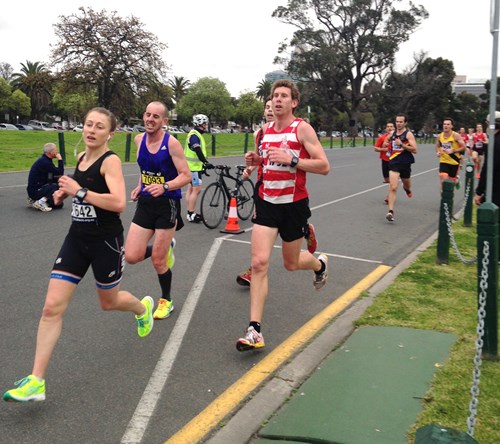Part 2: Off Season – Time to improve your running.
In part one of this blog we discussed the basics of how and why you should use the Off Season to improve your running. You can find Part 1 here http://fluidmovements.com/blog/2016/may/off-season-time-to-improve-your-running
In Part 2 it’s now time to get to the nuts and bolts of what training is required to significantly improve your running.

Lesley West on her way to a 36:53min 10k at the Albert Park XCR event last Off Season
Firstly it’s important to set out why you would want to do a specific run block. For most triathletes it would be to improve their run leg. In this case it could mean dedicating more of your overall triathlon training load to running for a period whilst it’s the off season. In turn this would mean allocating more recovery time to adapt to the increased run load.
The type of run sessions that may be included:
- Long Endurance Runs – Include increasingly longer easy runs over flat to slightly undulating courses to build aerobic endurance. Over time once you have built to around 2:00hrs, a good tip can be to split runs to share the increasing run mileage over more smaller runs, this can help the body adapt.
Example – Long flat and cross country runs building up to 2:00-2:20hrs, following that splitting runs (am) 2:00hrs (pm) 20-40mins
- Quality Strength Endurance Training – Gradually increased steady and variable paced running to build strength endurance. I do believe that these SE style runs have to be done in combination. One paced running sessions will see you racing at only one pace. Variable paced training in combination adds the extra change of pace element that gives a runner more speed due to the sudden pace acceleration of variable paced sessions. The best quality training sessions pound for pound to improve 10k to 21k average run speed.
Example – Steady – 30-40mins at 80-85%mhr. Variable – 2-3 x (3mins at 82-85%, 1:30min recovery, 5mins at 78-80%mhr, 1:30mins recovery, 1:00mins at 85-90%mhr) 2mins b/w sets
- Fast Interval Run Training – A key element for speed and cadence development. Early in the block, this element would be exclusively linked to the warm up as an active warm up tool via short interval accelerations, but as the runner’s condition increases, fast interval work can become a workout of its own in the training plan.
Example – 80m strides or builds as part of the warm up, or quality 200-400m track intervals later in the block.
Obviously the ratio of training elements would vary depending on the running history, ability and goals of the runner. A coach would be useful in this area to ascertain the best mix of training dependant on this. A more novice runner with less running history would likely have a higher percentage of easier aerobic running relatively.
The incremental build of training frequency, duration and intensity is known as progressive overload.
This important principle should be carefully applied to each athletes build through a period of training like this. The number one goal of an Off Season run improvement block is to remain injury free. Be considered when setting a plan, using an experienced coach to oversee the planning and implementation of the plan is recommended.
An End Goal – Finally if I was a short course athlete, a major goal of a run program such as this would be to improve my 10k run speed by it completion. Ideally the block would finish 1-2months prior to the start of the triathlon season, giving plenty of time to springboard of this great Off Season base and be flying by Race 1.
If I was an Ironman athlete, the run goal would be to improve my half marathon speed for the same reasons.
Hope this helps, and you all turn your run into a weapon come the regular season.
Coach Foz
Latest Blog Posts
See all